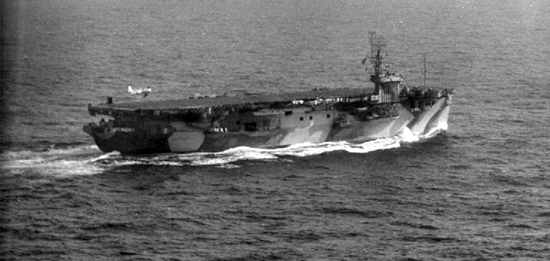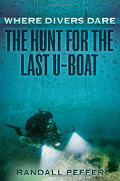Fighting the U-boats
Allied Navies
British-American Controversy
in the Employment of Escort Carriers
Battle of the Atlantic - WW II
Following the commissioning of USS Long Island in June 1941, a steady stream of the "baby flattops" began to pour from American shipyards. First the "Bogues", followed by the "Sangamons", "Casablancas", and the "Commencement Bays". In the period from January 1940 through July 1946, 86 CVE's were commissioned in the US Navy and some 38 CVE's delivered to the British Navy. The Atlantic escort carriers were used in a wide variety of jobs, including convoy escort and hunter-killer operations, aircraft transport, troop air-cover operations, and training/supply missions. Most of the British CVE's were employed in the Atlantic and Mediterranean while the vast majority of the American CVE's were assigned to the Pacific. Of the 86 American carriers, only 11 were assigned to the Atlantic for use against the U-boats and by the end of 1944, just 6 of the 11 remained in antisubmarine operations.
The British Navy was not happy with the escort carriers being delivered to them from the American yards and undertook extensive modifications before these ships were put into service. The CVE's were considered to be unstable and lacked design features the British navy considered important to safety. The CVE's were originally designed so that the aviation fuel tanks were vented to the sea through the bottom. As gasoline was drawn from the tank, seawater flowed in and the tank was always full, eliminating air space in which explosive vapors could form.

USS Bogue
Not favoring this system, the fuel systems in the British carriers were completely redone and 1,200 to 2,000 tons of concrete added as ballast to improve stability (as was also done on some of the American Bogue class carriers). Plans were also made to lengthen the flight decks and add provisions for additional fighter direction equipment. As a result the British carriers were delayed in becoming operational and many American officers began to feel they were spending more time in the yards than at sea.
The Allied Antisubmarine Survey Board, a joint British-American board, considering the problems the British were having in getting the escort carriers into service, recommended in August 1943 that the next 8 CVE's scheduled for delivery to the British navy be instead delivered to and operated by the American navy. This recommendation was subsequently accepted and implemented.
In October 1943, Capt. Marshal Greer USN, former commanding officer of USS Core, went to England to discuss the CVE situation with the British. His report upon his return contained the following; "It is my belief that the carrier squadrons are being well trained but that due to inexperience the inability of the officers to efficiently operate the carriers is deplorable, even though the young captains in command are, and have been, exceptionally fine young gunnery and submarine officers; and I now can better understand why it is necessary to run the carriers from Headquarters ashore like a puppet show instead of giving them complete freedom of action which we are successfully employing. It is my opinion that we must continue to accept the unpleasant truth that we can not expect much from British CVE's in the antisubmarine warfare in the near future. This, to my mind, results directly from the fact that they have not had our fortune of able leadership in Naval Aviation."
Another area of disagreement was the manner in which the escort carriers should be employed in anti-submarine operations. While both agreed the protection of the convoys from U-boat attack was of paramount importance, each navy had its own ideas on how the carriers should be operated to most effectively accomplish this objective. This division of opinion was founded in both the experience and training of the senior commanders, and to some extent reflected long held traditions within both navies. The British navy in WW II, while having developed and was operating aircraft carriers, considered the battleship to be the premier naval warship. Following WW I and into the 1930s the American navy had developed naval aviation to a high degree and by the onset of WW II, the aircraft carrier had superseded the battleship in American planning and strategy. This thinking was the background against which each navy employed the escort carrier.
The British navy favored operating the escort carrier in close support of the convoy. The carrier captains were selected from the ranks of surface ship and submarine officers and the carriers sailed within the convoy formations under the close tactical control of the Admiralty ashore. The escort carrier was considered to be primarily a sea-going mobile platform from which aircraft could be flown. The carriers aircraft were flown in patterns close in to the convoy designed to force the U-boats to remain submerged to escape detection which also inhibited their ability to move swiftly into attack position. Only those U-boats moving in close to and threatening the convoy were attacked. The carriers aircraft did not leave the convoy in order to actively hunt for and search out a U-boat if the U-boat was not an immediate threat to the convoy.
American escort carriers operated in a Task Group consisting of the carrier screened by 4 or 5 escorting destroyers; DDs or DEs, sometimes a mix of the two. The carriers were captained by senior naval aviators highly trained in aircraft carrier flight operations. The carrier captains were also in command of the Task Group in which the carrier was the flagship and they were allowed a high degree of freedom of action. The American carrier commanders believed every U-boat detected should be pursued and destroyed in the belief that a U-boat only driven off was a U-boat set free to try again. This position was further bolstered by the knowledge that German U-boat production continued in spite of the intense air bombing of the yards in Hamburg and Kiel and that newly constructed U-boats were continually entering the war. If the U-boats were allowed sanctuary, sheer numbers of U-boats might eventually overwhelm the convoys at sea.
In March 1943 Admiral King convened the Atlantic Convoy Conference in Washington DC. Over the next 12 days senior commanders from both navies addressed questions relating to the antisubmarine war. From this conference came plans for new convoy schedules, expansion of the HF/DF network, the use of escort carrier groups, and the division of responsibilities between the Allies in the Atlantic.
The resolution of this last question was of extreme importance. As the two navies attempted joint operations there were always problems of operational priorities, differences in communications systems and tactical and operational procedures, which complicated matters. At one point, a Supreme Naval Commander - Atlantic had been considered, but this would have entailed placing US naval forces under British command or British naval forces under US command, neither option being found acceptable to either side. The decisions taken at the Atlantic Convoy Conference regarding responsibilities at least provided an acceptable modus operandi, which allowed the Allies to get on with the war at sea. It was agreed the Americans would handle the central Atlantic convoys and the British/Canadians the northern convoys. Each navy was to organize its forces and operations in whatever manner was deemed most efficient for its zone of operations.
The first American carriers arriving in the Atlantic in early 1943 soon found the practice of operating the carrier within the convoy screen to be inefficient. Launching and landing aircraft requires the carrier turn into the wind, which of course was not always the direction in which the convoy was sailing. Frequent maneuvering within the convoy, particularly at night during flight operations, disrupted convoy operations and always entailed the risk of collision. The US navy carriers then adopted a mode of operation where the carrier and its escorts sailed outside the convoy but remained close enough to provide air cover.
The onset of "Hunter-Killer" operations in the central Atlantic was signaled by a communication from Admiral Ingersoll in May 1943 in which was stated "...it is decided that close air support of central transatlantic convoys was a waste of effort; that it would be better to leave the commanders of escort carrier groups complete discretion to hunt down submarines where HF/DF fixes indicated...". With these orders the American escort carriers were unleashed and the central Atlantic became a hunting ground for Santee, Bogue, Core, Card, and Block Island, soon to be joined by the new Casablanca-class carriers coming on station in early 1944.
Throughout the war the British navy continued its policy of "close in convoy support" with the carriers employed in a defensive role, never really subscribing to the "Hunter-Killer" concept. As it turned out, both concepts worked to the allied advantage. The strong air support of the northern arctic convoys supplied by the British carriers and land based aircraft eventually forced a reduction in U-boat attacks. With the American carriers ranging the central Atlantic there was now no place the U-boats could find respite from the constant threat of attacking aircraft and DEs actively seeking them out.
In spite of the controversy over the escort carriers, the British and American Navies worked out their differences and the final result was the defeat of the U-boats in the Atlantic.
Written by Don Baker


